1The Development Prior to Founding
From Sansei-kan to Fukuoka Prefectural Hospital
The Sansei-kan was established as a medical school for teaching both Rampo (Western medicine) and Kampo(Chinese medicine). The school director was Yushi Takeya, a domain doctor of Fukuoka. The Sansei-kan continued to exist even after the so-called “Haihan-chiken” (abolition of feudal domains and establishment of prefectures) and continued to exist until it was closed with the promulgation of the school system in August 1872.
For a while, after the Sansei-kan was closed there was an absence of educational institutes for medicine in Fukuoka.

Last Graduation Photograph of Fukuoka Medical
School(1885)
In 1874, Fukuoka prefecture founded a clinic in the so-called Shuyu-kan, a former domain school. The clinic moved to a new building built in Nakashima-cho, a village in Hakata, and reopened as the Fukuoka Prefectural Clinic in June 1877 with Kazu Okochi as its first director. Even though the clinic put more emphasis on medical
education rather than medical treatment, due to a shortage of teaching staff it was unable to provide enough education.
To improve the situation, Fukuoka Prefectural Medical School newly opened in July 1879. It was launched as an institution that emphasized medical education both in name and reality. At the same time, Fukuoka Clinic was closed. However, because the discussion in the prefectural assembly shifted in favor of abolishing the school, it eventually had to close in March 1888.
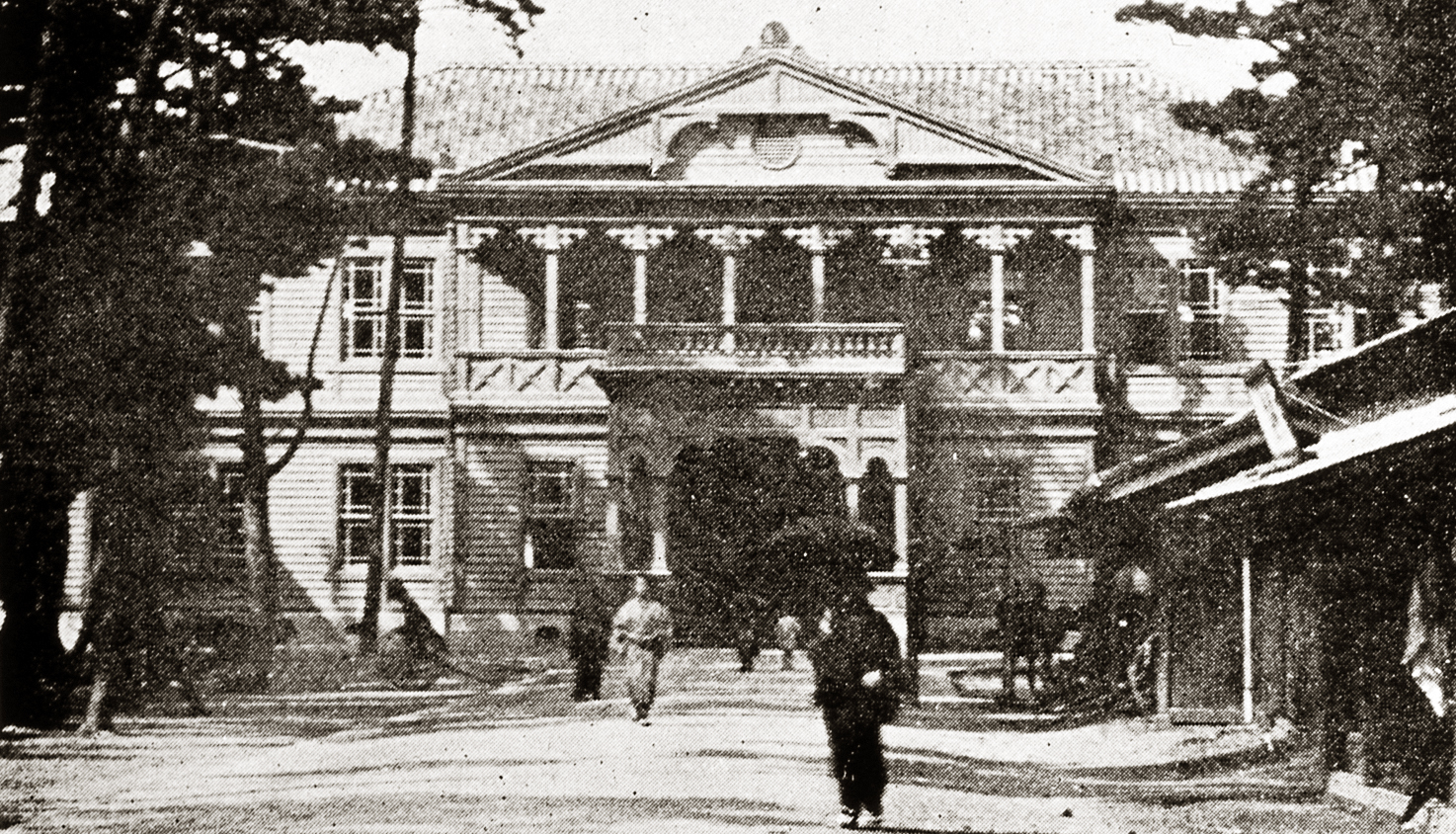
Fukuoka Prefectural Hospital - Main Building
Doctors in Fukuoka Prefecture demanded to preserve the function of the hospital even after the Fukuoka Prefectural Medical School was closed. In April 1888, Fukuoka Prefectural Hospital was opened to respond to their requests. Its first director was Harutoyo Omori.
Though the hospital used buildings from before the Fukuoka Clinic era at the beginning, it later moved in June 1896 to a newly constructed building in the village of Chiyo in the Chikushi district to respond to the increase of visitors.
The Establishment of Fukuoka Medical College of Kyoto Imperial University
After the Sino-Japanese War (1894-1895), secondary and higher educational institutions were expanded upon. The Imperial University of Kyoto was established in June 1897, and the establishment of a medical college was decided in the cabinet meeting of September 1901. Fierce competition occurred between Fukuoka, Kumamoto and Nagasaki prefecture to become the home of this new institution. Fukuoka Prefecture and Fukuoka City decided to contribute funds and land for building the college. In addition, they decided to offer a location and buildings as well as the facilities for the Fukuoka Prefectural Hospital. As a result, the Minister of Education, Dairoku Kikuchi declared at the 16th Imperial Diet at the end of the same year that the college was to be built in Fukuoka. Fukuoka Hospital possessed the best facilities and staff at the time in Kyushu, which played a crucial role in choosing Fukuoka for the construction of the college.
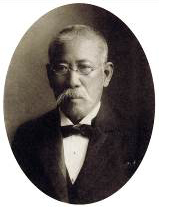
The first president of
Fukuoka Medical College -
Harutoyo Omori
It was decided that the Medical College would be constructed as a branch school of Kyoto Imperial University because only universities with multiple faculties were permitted to carry the name of Imperial University. Thus, the Fukuoka Medical College of Kyoto Imperial University was established in April 1903. Harutoyo Omori took office as the first president of both Fukuoka Medical College and its affiliated clinic.
In September 1903, its first entrance ceremony was held, and sixty-five students enrolled at the Fukuoka Medical College. Fukuoka Medical College had produced 330 graduates in total until it was transformed to Kyushu Imperial University in 1911. When the college was launched it only counted four courses. However, later more courses would be added until

University Campus(1920)
by 1911 there would be a total of twenty-two courses. The affiliated clinic also increased the number of departments from five to ten, and the number of beds from 300 to 534 by 1910. In this way, Fukuoka Medical Clinic expanded gradually and formed the foundation of Kyushu University.
2Establishment and Development of Kyushu University
Establishment of Kyushu Imperial University and Engineering College
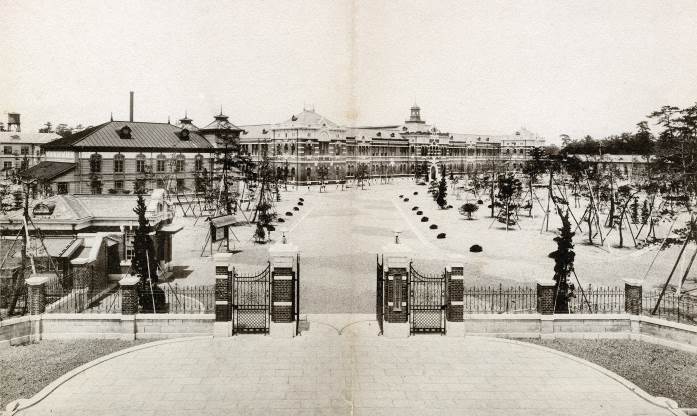
The Main Gate of the Engineering College(1914)
The Fukuoka Medical College of the Imperial University of Kyoto had developed steadily. In that same period, the plan to establish more imperial universities began to take shape. The Ministry of Education included the cost to establish Fukuoka Engineering College as contingent expenses in the budget for the fiscal year of 1907, but the project faced difficulties as the expenses were rejected by the assessment of the Ministry of Finance. However, the Koga family, which faced harsh public criticism over the Ashio Copper Mine Pollution Incident, offered to donate a large sum of money for the establishment of the college to soften public criticism. The Fukuoka Prefectural Assembly also decided to contribute the land and donate funds for the construction of the college. Thus, the financial problem was resolved, and the construction of the engineering college in Fukuoka became definite. The town of Hakozaki was selected as the location for the college. In January 1911, the "Kyushu Teikoku Daigaku ni Kansuru Ken" (Edict concerning Kyushu Imperial University, The Imperial Edict no. 448) was carried out and the Imperial University of Kyushu was established. Kenjiro Yamakawa, former president of Tokyo Imperial University and later president of the Meiji College of Technology, took office as its first president.
The Imperial University of Kyushu was composed of two colleges: the newly established College of Engineering and the Fukuoka Medical College which was part of the Imperial University of Kyoto. The College of Engineering consisted of six departments and nineteen courses when it opened. The established departments were the Department of Civil Engineering, Mechanical Engineering, Electrical Engineering, Applied Chemistry, Mining, and Metallurgy. In October 1911, its first eighty-two students enrolled. The first person to take office as dean at the College of Engineering was Junzo Nakahara. Furthermore, Motonosuke Goto, who was the head of Fukuoka Medical College, became the first dean of the College of Medicine after it was reorganized as a college of the Imperial University of Kyushu.
Establishment of the Faculty of Agriculture
Kyushu Imperial University already aspired to establish a College of Agriculture since Kenjiro Yamakawa, its first president, held office. Its second president, Bunji Mano, published his statement insisting on the establishment of a College of Agriculture in the “Fukuoka Nichinichi Shimbun” newspaper in January 1915. In response, Fukuoka prefecture started a campaign for the establishment of the college. Meanwhile, Saga, Kumamoto as well as Kagoshima prefecture all began their own campaigns to invite the college to be set up in their prefecture, inciting fierce competition between the prefectures. In the end, however, it was decided to construct it in Fukuoka Prefecture. The Faculty of Agriculture of the Imperial University of Kyushu was constructed adjoining the north-east side of the Faculty of Engineering. In April 1921, the faculty accepted its first three students and started giving classes.
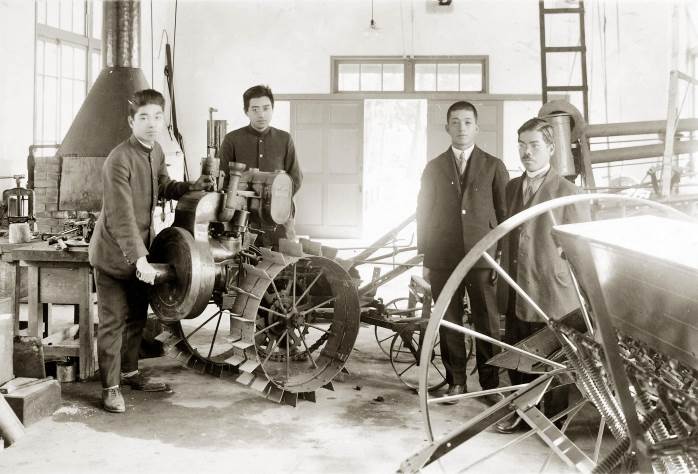
Agricultural engineering laboratory(1925)
Kosuke Honda took office as the first dean of Faculty of Agriculture. At first, the Faculty of Agriculture began with five courses and three departments (the Department of Agronomy, Agricultural Chemistry, and Forestry) and increased to twenty-five courses in 1923. The development of the Faculty of Agriculture was more or less completed.
The Faculty of Agriculture’s university farm was established in the village of Nakabaru in the county of Kasuya in 1921. The University Forests were also established as a basic property belonging to the university even before the Faculty of Agriculture was established. Forests for exercise were established in Karafuto (Sakhalin) and Chosen (Korea) in 1912, and in the following year, one was established in Taiwan also. These University Forests became facilities attached to the Faculty of Agriculture after Forestry was established as a subject at the faculty in 1922. In the same year, the Sawara and Kasuya exercise forests were established. Moreover, in 1926, the Kita-Chosen (northern Korea) Forest was established and the original Chosen Forest was renamed to Minami-Chosen (southern Korea) Forest.
Establishment of the Faculty of Law and Literature and Construction of the Library
After the First World War (1914-18), the government adopted a higher education enhancement policy. The establishment of the Faculty of Law and Letters in Kyushu and Tohoku Imperial University was decided as a part of that policy. The preparation for the establishment of the Faculty of Law and Literature at the Imperial University of Kyushu advanced as the university employed Tatsukichi Minobe, a professor at the Imperial University of Tokyo, as a member of the founding committee, and the faculty would finally be established in September 1924. It consisted of the Department of Law, Economics, and Letters, and had eight divisions. When it was established, Minobe held the concurrent post of a professor of Kyushu Imperial University and served as acting dean of the faculty. In 1927, Kanehide Shinomiya was officially inaugurated as the dean of Faculty of Law and Letters. The number of divisions increased to forty-four and the faculty was completed as planned.
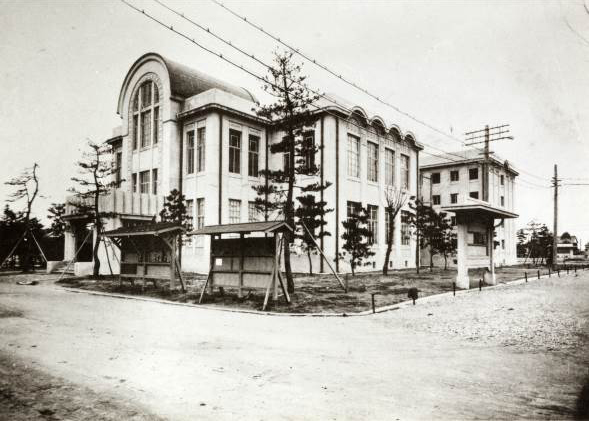
University Library - Main Building(Completed in 1925)
Not only graduates of senior high schools (also referred to as Seikei) but also graduates of vocational schools such as higher commercial schools (also referred to as Bokei) were permitted to enroll at the faculty. There were more Bokei enrollments than Seikei ones. Of the first students that enrolled seventy-four were Seikei and 128 were Bokei. Moreover, according to university regulations, graduates of women's normal schools were permitted to enroll, and the school saw its first two female students enter in 1925. In May 1922, the attached library of Kyushu Imperial University was established. However, at first, it only consisted of a single room at the campus of the Faculty of Medicine. Three years later, in June 1925, the library received its own building at the campus of Hakozaki.
Student Life and Campuses in the Meiji and Taisho Period
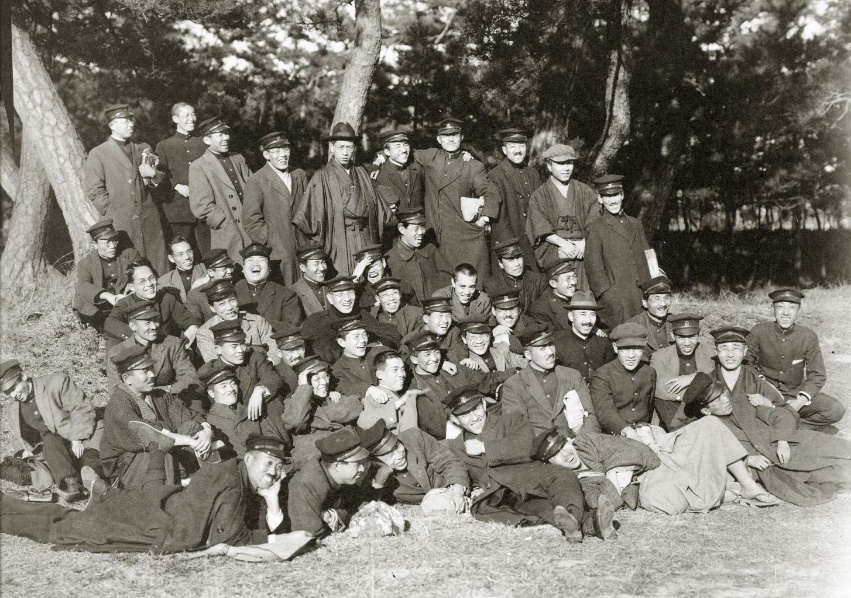
Medical school student group photo(1919)
In November 1903, the Students' Association (Gakuyu-kai) of Fukuoka Medical College was founded, and the first Art Club and Sports Club were installed. With the establishment of Kyushu Imperial University in 1911, regulations
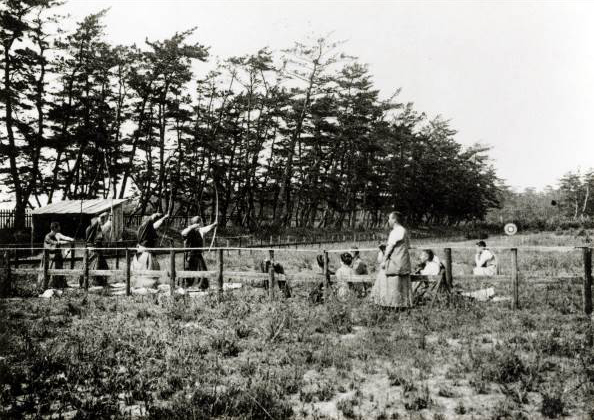
Fukuoka Medical College - Archery Club(1915)
for the sports clubs were enacted, and six sports clubs were set up. The Sports Clubs of the Students' Association of Fukuoka Medical College merged with the Athletic Association of Kyushu Imperial University. In April 1924, the regulations of the sports clubs were revoked and new regulations for the Students’ Association of Kyushu Imperial University were set in place and the Students’ Association launched with the president of the college as chairman. It started with only the sports clubs after which, a year later, three culture clubs were set up. With this the Students’ Association took shape.
Some groups other than the Students’ Association were also established by students during that period. For instance, the Young Men's Christian Association was established in October 1905, and the Young Buddhist Association was established in May 1907. These groups occupied themselves with, among other things, missionary work and free medical treatment. In 1912, the Kyushu Imperial University Philharmonic Orchestra was established, which was the first of its kind in all of Japan.
In December 1923, the main building of the Faculty of Engineering burned down. The following year the university began building temporary classrooms which were completed in March 1925. The faculty’s new main building was erected at the same place where the previous building burned down, and it opened in November 1930. In August 1925, there was another fire at the affiliated hospital of the Faculty of Medicine, and important rooms and medical wards were destroyed by the flames. Because of this, problems arose concerning the relocation of, among other things, the office of the university headquarters which was located within the faculty of medicine. During the following month, it would be relocated within the school buildings of the Faculty of Law and Literature. In 1928, it relocated again to the first annex of the Faculty of Engineering.
3The Imperial University of Kyushu during the Prewar Period
Prewar Student Life and Ideological Problems
During the Taisho period, beginning with the so-called Shinjin-kai of the Imperial University of Tokyo, student movement organizations were founded. At Kyushu Imperial University, at the end of the Taisho period, student movements began as an activity of the social
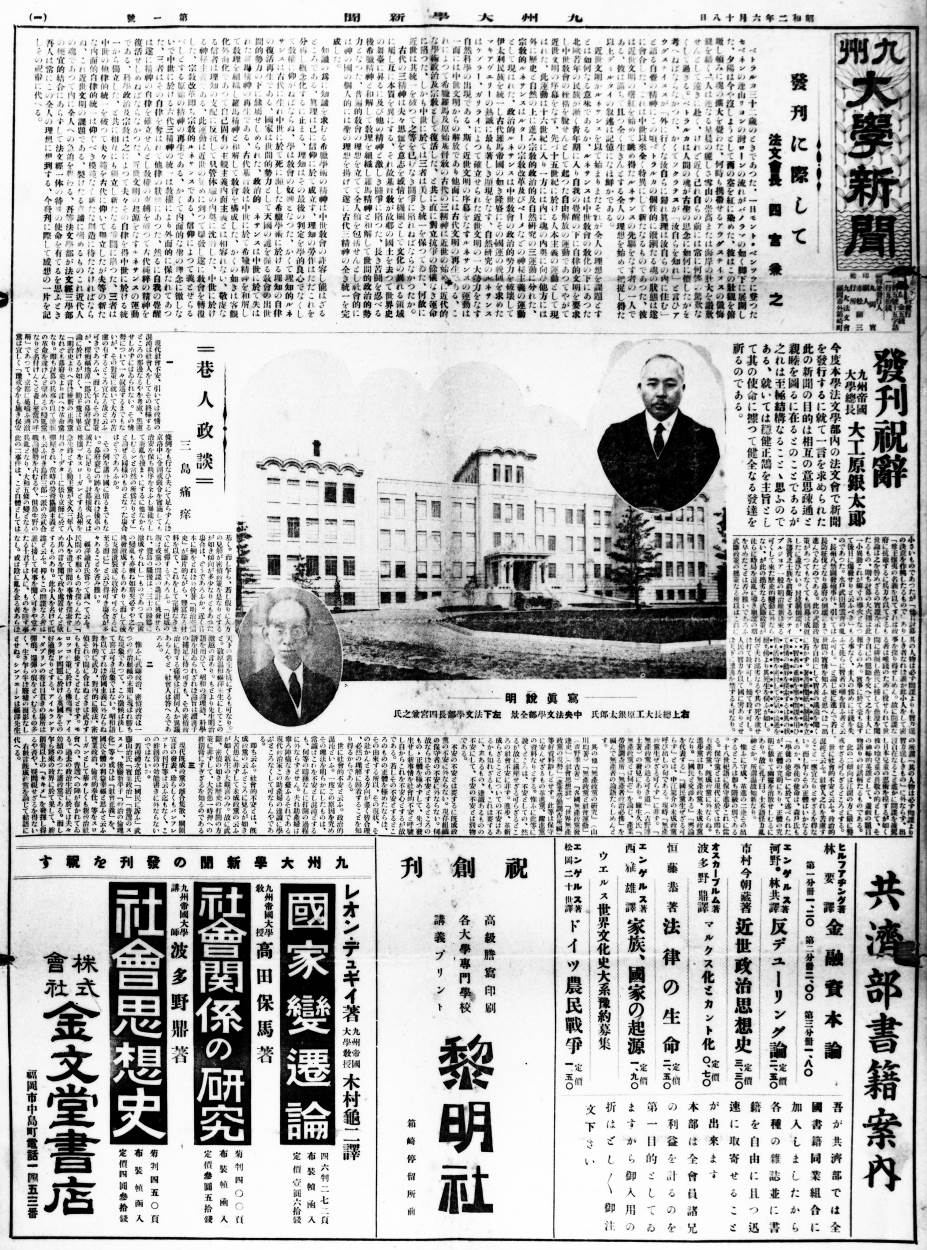
First issue of "Kyushu Daigaku Shimbun" (June 18, 1927)
sciences with students of the Faculty of Law and Letters playing a central role. In these circumstances, in July 1927, the Hobun-kai was created by students of the Faculty of Law and Letters in opposition to the Students' Association, and they launched a journal called “Hobunronso” as well as a university-wide bulletin called the “Kyushu Daigaku Shimbun”.
The establishment of the Hobun-kai overlapped with the period in which the government strengthened censorship targeting the student’s thought problem. In 1928, the so-called "March 15 Incident" occurred, and the Ministry of Education decided to punish students who were involved with the incident, to break up the Sociology Research Society or “Shakaikagaku Kenkyu-kai”, and to punish leftist professors. The Imperial University of Kyushu punished involved students by, for instance, expelling them from school, broke up the Culture-Society Study Group or “Shakai-Bunka Kenkyu-kai” of the Hobun-kai, and made three professors resign: Itsuro Sakisaka, Tomoyuki Ishihama, and Hiro Sassa. The crackdown on the movement continued, until in 1932 student movements were almost completely dissolved.
In the wake of leftist student movements being dissolved, rightist student movements took their place. After the Manchurian Incident in 1931, the Manchuria-Mongolia Problem Study Group and rightist groups such as Kodo-kai and Kokko-kai were established.
The emergence of student movements and ideological issues overlapped with the Great Depression. The Japanese economy fell into a serious recession, many students struggled financially, and the number of students in arrears with their tuition fee increased rapidly. Even if they graduated, they faced difficulties in finding jobs. This difficult social situation made these students aware of social contradictions, which made it one of the causes for the student movements.
International Exchange at the Imperial University of Kyushu
In 1910, Kim Taejin came from the Great Korean Empire to enroll at Fukuoka Medical College. He was the first overseas student in the history of Kyushu University. However, Kim entered the university as an associate student and not as a regular student. In this sense, the first exchange students that attended Kyushu Imperial University after its establishment were three Chinese students who enrolled in 1913. From 1923 onwards, the number of Chinese students increased rapidly after the Japanese government, as part of a project relating to Chinese culture, started to provide a subsidy for tuition. After that, the relationship between Japan and China would repeatedly better and worsen and with that, the number of Chinese students too would increase and decrease. Even considering this, Chinese students would account for the majority of overseas students until the outbreak of the Second Sino-Japanese War in 1937.
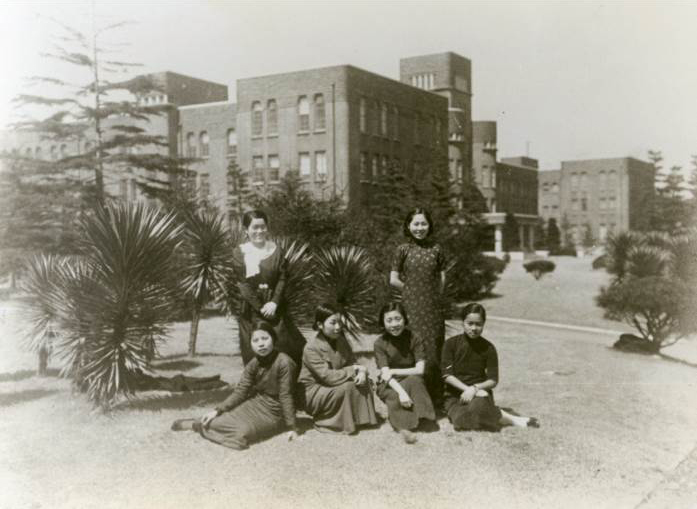
Chinese students of the Medical School (~1935)
Students from Taiwan and Korea which became Japanese colonies were institutionally treated as overseas students. The number of students from both areas increased from the 1920s onwards, especially the Faculty of Law and Letters and the Faculty of Agriculture saw many Korean students enroll.
Although transportation was not as developed as it is nowadays, many notable foreigners visited the Imperial University of Kyushu. In 1913, Sun Yat-sen (at the time known as Sun Wen) visited and inspected the Medical College. He also produced a piece of calligraphy which reads "Xue duo ai ren", (学道愛人 or “Gakudoaijin” in Japanese) meaning “Study the way, Love People”. In 1922 Kyushu Imperial University was visited by Albert Einstein when he was on a tour in Japan giving lectures at various locations.
On the other hand, the University’s academic personnel itself would often go abroad for research purposes. With the establishment of each faculty, most of the candidates of the academic staff would first study in western countries before they took up their post at the university. Afterwards, the university would sequentially send mainly assistant professors abroad. Especially since the 1930s, research activities in Asia flourished, and many academics conducted fieldwork mainly in China and the puppet-state of Manchukuo.
The Establishment of the Faculty of Science and Affiliated Institutes
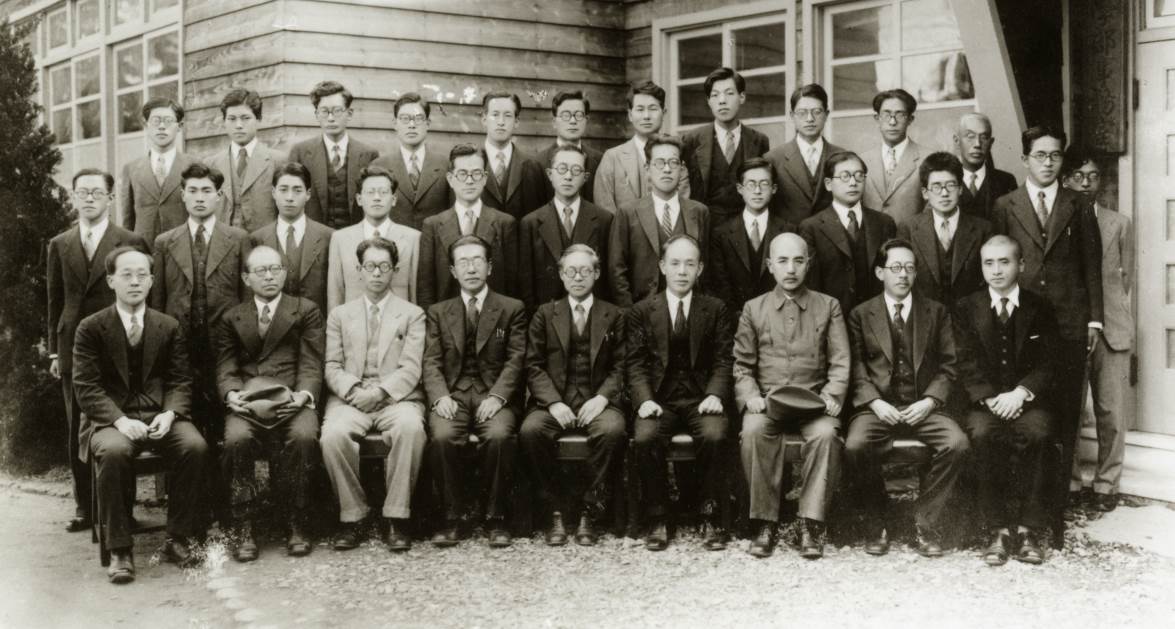
Founding Professors, Faculty of Science(1941)
The necessity for a college of science was already insisted upon since the days of Fukuoka Medical College, but the university only began working toward its establishment after Mano took office. However, the establishment of a faculty of science took a while due to problems with preparing personal and donated funds.
In this situation, in 1938, it was decided to accept a donation of one million yen from Takakichi Aso, and at last, it was decided to establish the faculty. In April 1939, the Faculty of Science was established with three departments and eleven courses, and its first thirty students enrolled. Hisamitsu Nishi took office as the first dean of the faculty. Thus, Kyushu Imperial University took shape as a university which consisted of multiple faculties. However, due to the war, it was impossible for the university to make enough preparations regarding its buildings and facilities and could only build temporary school buildings.
The Research Institute for Balneotherapeutics was established in November 1931, which preceded the establishment of the Faculty of Science itself. It was the first attached institute of Kyushu Imperial University, and there was no similar research institution in Japan at that time. The institute was constructed near the city of Beppu in Oita prefecture and began offering consultations in the following year.
The number of attached institutes increased suddenly after the start of the Pacific War in December 1941. At first, the Research Institute of Fluid Engineering was established in January 1942. It was urgently needed during wartime because it was deemed important in the development of aircrafts and ships. Thereafter research institutes were established one after another. The Research Institute for Elasticity Engineering was established for the improvement and progress of weapons in February 1943, the Research Institute for Wood and Lumber began studying lumber utilization to combat the shortage of materials in May 1944, and the Research Institute for Recycle System Engineering began activity with the goal of studying metal materials in January 1945.
The Fukuoka Senior High School and the Kurume Technical College
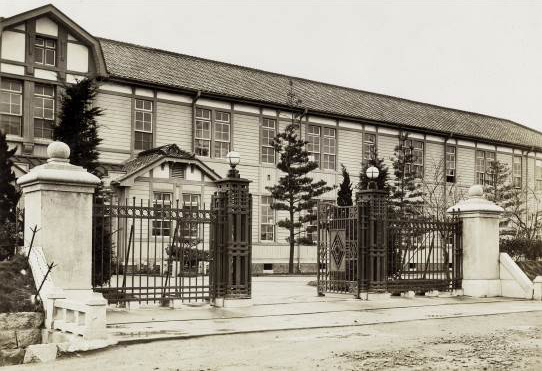
Fukuoka Senior High School - Main Building (~1931)
In 1949, two schools were incorporated into Kyushu University when it was reorganized under the new educational system. These were the Fukuoka Senior High School and the Kurume Technical College. Both schools were established as a senior high school and a vocational school respectively under the old system.
Fukuoka Senior High School opened in April 1922. After the First World War, higher education was expanded upon and it was in this period that this school was established. In its first year, the school saw more than a thousand candidates apply for two hundred available seats, this led to problems regarding the pass rate as competition
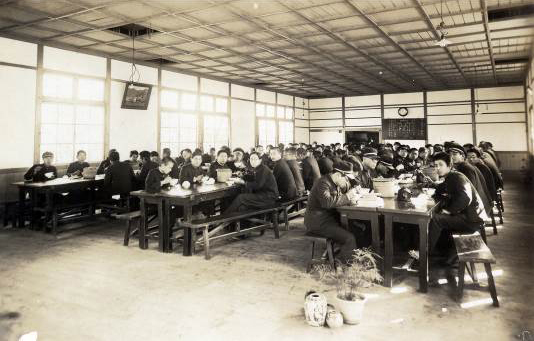
Fukuoka Senior High School
- Gakuji Dormitory Dining Room(1931)
naturally increased over five times. The first president to take office was Otoji Akiyoshi who would stay in office for fifteen years. He was known as a Japanese ultranationalist and had a strict attitude toward not only student movements but also self-government and freedom which were characteristics of senior high schools under the old system. On the other hand, he achieved good results regarding university enrollment. Of the first 154 graduates, seventy-two entered Kyushu Imperial University, forty-eight went to Tokyo Imperial University, and thirty to Kyoto Imperial University.
After the Second Sino-Japanese War began in 1937, while there was a shift to a wartime regime, an expansion in production capacities was required and therefore training engineers became an imperative. In May 1939, the Kurume Engineering College was established with a capacity for two hundred students and five departments: The Department of Machinery, the Department of Precision Instruments, the Department of Machine Tools, the Department of Mining Machines, and the Department of Mining. Shunjiro Kobayashi, a professor at Kyushu Imperial University, took office as the first president of the college. In the following year, the Komorino campus was finished, and the Department of Industrial Chemistry was added in 1942. The name of the school was changed to Kurume Engineering Vocational School in April 1944. At the same time, the Department of Machinery, the Department of Precision Instruments, and the Department of Machine Tools were integrated into the Department of Machinery. Likewise, the Department of Industrial Chemistry was renamed to the Department of Chemical Engineering, and the Department of Rubber Industry was newly opened.
Transition to Wartime Regime and “Gakuto-Shutsujin” and “Gakuto-Doin”
When the Second Sino-Japanese War broke out, it affected Universities too. In the year following the outbreak of the war, the Collective Labor Service was started. While military training had hitherto been voluntarily attended by students, from 1939 onwards it became mandatory. The so-called Gakuyu-kai, an association that aimed to promote friendship amongst students was reorganized in April 1941 as the Kogaku-kai an association with the goal to discipline the students' body and mind. In September of the same year, the so-called Hokoku-tai was formed and put in charge of labor service and protection of the university. In this way, students' organizations were restructured to prepare students for deployment to the front and to defend the home front. In the same year, the government decided to shorten the duration of school, which led to the students of the year of 1941 to already graduate in December the same year. Moreover, from 1942 onwards students would see their year shortened half a year, which led to the students of 1942 to already graduate in September. The students of 1943 would even see their education being shortened by a year as they would now only stay for two years at their institution.
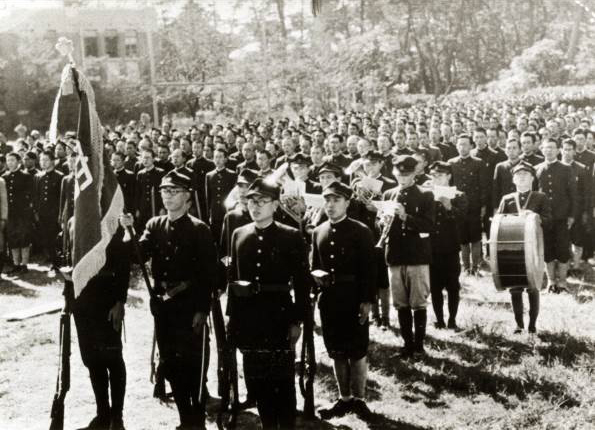
Farewell party for students drafted for military duty
On December 8, 1941, the Pacific War broke out. Although the Japanese army’s victories would pile up in the beginning, as the counteroffensive of the allied forces began in the following year, the state of the war worsened, and the mobilization of students became stricter. In 1943, the government abolished the temporary exemption of students from military service, and as a result, in a process referred to as “Gakuto Shutsujin” (学徒出陣), the recruitment of students increased with a focus on students from the humanities. Many students of Kyushu Imperial University and Fukuoka Senior High School left for battle, and many of them lost their lives on the battlefield. Furthermore, to combat labor shortage that resulted from the Second Sino-Japanese War taking longer than expected, the mobilization of students became stricter. From 1944 onwards, the Japanese government began to mobilize labor forces throughout the year, and as a result, university students from all over the country got sent to factories and other places where labor was direly needed. The government decided the suspension of all classes for one year from April 1945 onwards, and the Hokoku-tai was reorganized into the Gakuto-tai to prepare for the decisive battles.
In June 1945, during the last period of the war, Fukuoka City was burned down during large air raids by US forces. However, the Imperial University of Kyushu was little damaged. On August 15, Japanese citizens were informed of the end of the war through a message by the Emperor broadcasted via radio (Gyokuon Hoso). The war that had worn the universities out finally ended.
4Kyushu University under the New Education System
The Founding of Kyushu University under the New Education System
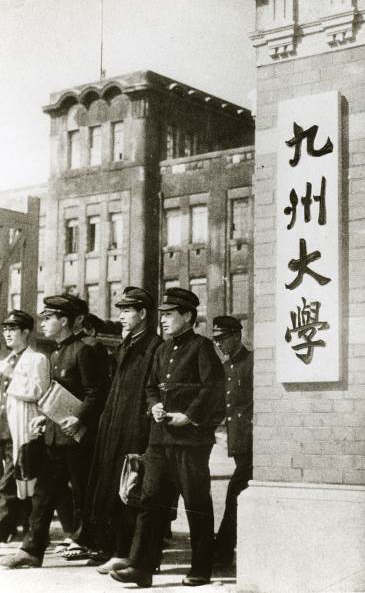
Poswar name change from Kyushu
Imperial University to Kyushu
University(1947)
With the end of the war, it was decided that Japan, under the guidance of the General Headquarters, would carry out various reforms. With this, Japan’s education system too would see significant reforms concerning its system and principles. Where universities under the old system would only take three years to complete, under the new system universities saw their curricula increase to four years in 1949. The old-system senior high schools and vocational schools were abolished, and most of them became colleges of liberal arts or other faculties of the reorganized universities.
In October 1947, as the Ordonnance Regarding Imperial Universities was renamed to the Ordonnance Regarding National Universities, the Imperial University of Kyushu was renamed to Kyushu University even though it still fell under the old system. Moreover, on May 31, 1949, with the enactment of the National School Establishment Law, Kyushu University became a school under the new system. At the same time, the Fukuoka Senior High School and the Kurume Engineering College were incorporated into Kyushu University and became the Fukuoka Senior High School and the Kurume Engineering College of Kyushu University respectively. In July, the first, second, and third branch school were built and provided general education. The second and third branch school were placed in Kurume City. However, the third one was abolished in 1951, and the second one was integrated into the first branch school and disappeared in 1955.
Kyushu University’s research institutes too were reorganized. The Research Institute for Recycle System Engineering was abolished shortly after the war. In May 1949, the Research Institute for Wood and the Engineering College of Kurume were integrated, reorganized, and opened as the Research Institute of Science and Industry. At the same time, the Research Institute of Industry and Labor was newly established. In April 1951, the Research Institute for Fluid Engineering and the Research Institute for Elasticity Engineering were merged together.
Although a graduate school was already set up before the war, it did not have an independent curriculum and was practically like a continuation of an undergraduate school. The School Education Act, which was enacted after the war, specified the purpose of graduate schools as independent educational institutes and established graduate schools under the new system. In April 1953, as the National School Establishment Law was amended, eight graduate schools were established: The Graduate School of Literature, Education, Law, Economics, Science, Pharmacy, Engineering, and Agriculture. 182 students enrolled in the first year.
The Abolishment of Faculty of Law and Letters and Establishment of Four Faculties of Humanities
The Faculty of Law and Letters had been separated into the Departments of Law, Economics, and Letters since its founding. This tendency had been increasing year by year. As a result, the split into three departments after the war was a natural course of things. In April 1949, the Faculty of Law and Letters was abolished, and the Faculties of Literature, Law, and Economics were established.
In May 1949, the Faculty of Education was opened at the same time as the University of Kyushu was established under the new system. One of the faculty’s missions was to provide university-wide lectures and practice for the teacher-training curriculum, and training for education coordinators and researchers of pedagogy. Because of that, the graduate school was positioned as the main part and only carefully selected a maximum of twenty-five students from the undergraduate courses to enter. At its establishment, the faculty would only count a single course, however, by 1954 that number would increase until there were eight courses. Lectures began in 1951. At first, Hikata Ryusyo, the dean of the Faculty of Literature, held an additional post as the dean of the Faculty of Education, a position which in 1953 would be assigned to Masunori Hiratsuka.
Post-War Student Life and Student Movements
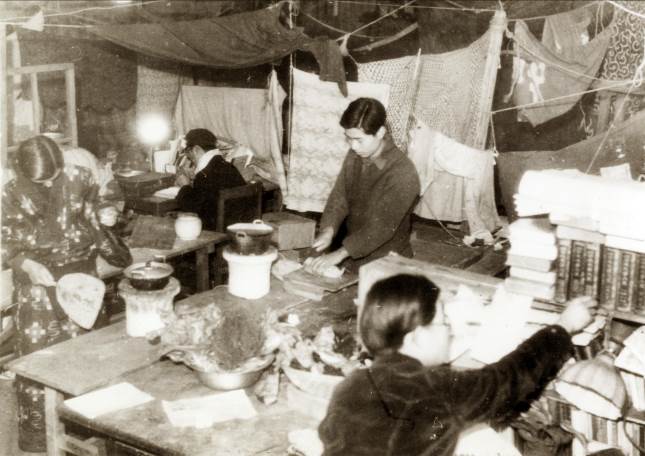
Student Living in Assembly Hall Ⅱ around 1947
Due to the war, many production facilities in Japan were destroyed or went to ruin. The end of the war led also to rapid inflation and food crises and as a result, students experienced extreme poverty. From 1947 onwards, to tackle the extreme housing crisis, Kyushu University built four dormitories. Students often had to do part-time jobs to pay for school and living costs, and many of them had to skip classes because of their part-time jobs.
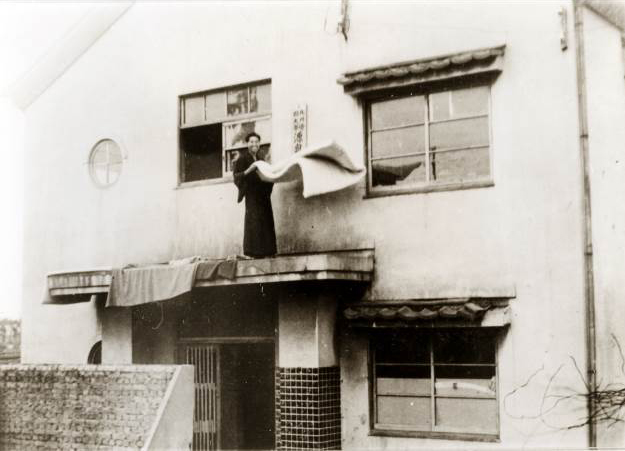
Kyushu University - Gensen Dormitory(1950)
The Constitution of Japan which was enforced in May 1947, guaranteed fundamental human rights which had been limited under Japan’s Imperial Constitution. Especially for universities, it was important that academic freedom and the freedom of thought and faith were guaranteed. Although faculty members and students of universities were often suppressed and punished due to the so-called “thought problem” or “shiso mondai” under Japan’s Imperial Constitution, such problems did not happen after the war.
Shortly after the war, student movements saw a revival. At first, beginning with the Faculty of Law and Letters, a student council was organized in May 1947. In the following year, a university-wide committee for self-government was set up. The Gakuyu-kai, which was reorganized to Kogaku-kai during the war, was once again reformed to the Gakuyu-kai in 1948. In 1949 both organizations were merged and launched as a new Gakuyu-kai which became the organization for student-self-government for Kyushu University. The Gakuyu-kai became the center of student movements at Kyushu University. When W.C. Eelles visited Kyushu University in 1950, the Gakuyu-kai protested.
Kyushu University in the Period of High Economic Growth
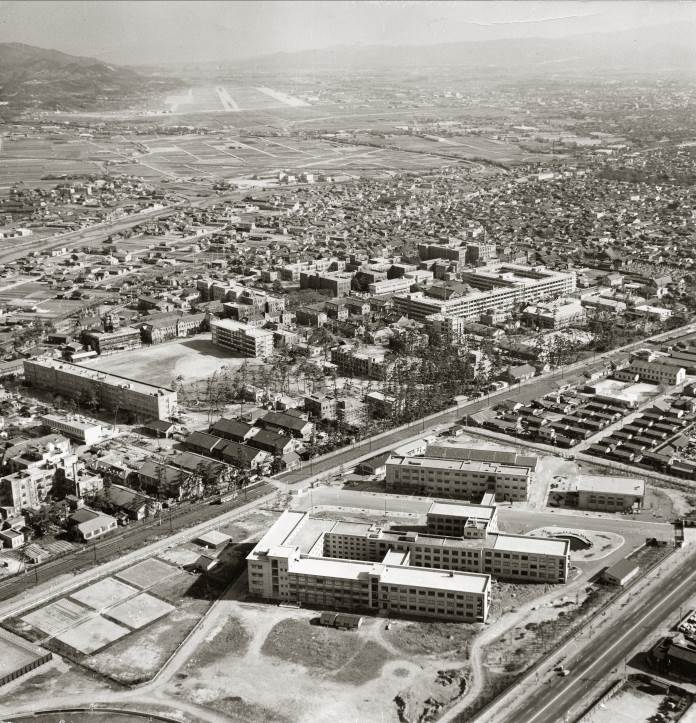
Relocation of the departments of humanities(1963)
Although Japan’s economic level significantly dropped because of the war, in the late 1950s the economy began to grow rapidly. This economic growth led to the expansion of universities mainly in the fields of science and engineering. We compare the situation of Kyushu University at the start of the economic growth in 1955 and its end in 1973. While of the 1052 students that entered in 1955 only 53% entered into the sciences, the total number of enrolling students increased by 89% to 1991 students by 1973 from which eventually 69% entered into the sciences. In this period, the Faculties of Pharmaceutical Sciences and Dentistry were established and, with a focus on the Faculty of Engineering, courses and subjects increased.
With the increase in courses and divisions, new buildings were built one after another. Though students of the Department of Science had been forced to use a temporary campus since its establishment, the construction of its main building was finished in March 1960. In the Affiliated Hospital of the Faculty of Medicine, departments had conducted medical treatment activity in each building independently. However, the hospital started to construct new hospital buildings to integrate and unify medical activities in 1958 and completed the buildings in September 1965. On the other hand, the departments of humanities had continued to use buildings of the former Faculty of Law and Letters. As it became cramped it decided to move to a new site on National Highway 3. The relocation of four of its faculties was accomplished in 1964.
Establishment of the Faculty of Pharmaceutical Sciences and the Faculty of Dentistry
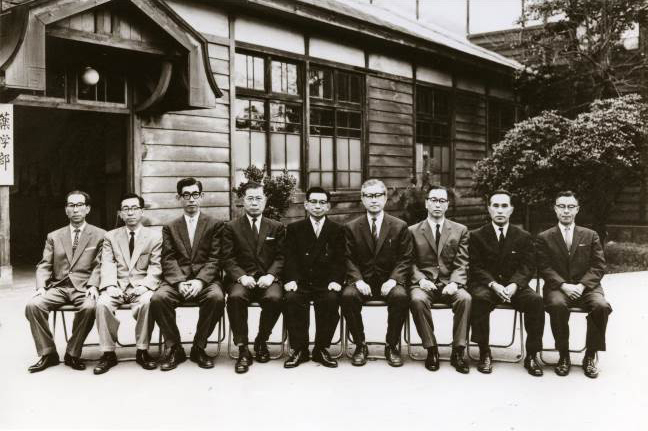
Founding Professors and Staff, Faculty of Pharmaceutical
Science(1964)
Entering the 30s of the Showa period (1955-1964), former imperial universities installed faculties of pharmaceutical sciences one after the other. Kyushu University too set up its Faculty of Pharmaceutical Sciences as part of this trend. The Faculty of Pharmaceutical Science’s predecessor was the Department of Pharmaceutical Sciences which was founded in April 1950. At its establishment, the Department of Pharmaceutical Chemistry too was launched in unison. The faculty was launched initially with two departments and seven courses (whereas the department had to wait for a year before it saw its first two courses being established) and its first generation of students counted seventy-eight students. Hisao Tsukamoto, a former professor at the Department of Pharmacy at the Faculty of Medicine, took office as the first dean.
The Faculty of Dentistry was established in June 1967. Its predecessor was the Department of Dentistry of the Faculty of Medicine which was founded in May 1922. When the Faculty of Dentistry was established, it had three courses. The number of courses increased accordingly with the years up to fifteen courses by 1971. The inaugural class counted forty-two students, of whom two were overseas students. Hiroshi Fujino took office as the first dean of the faculty and the first president of the affiliated hospital.
Departments and divisions were added one after another in existing faculties. Especially the Faculty of Engineering saw ten departments being added from 1954 to 1967, which doubled the number of courses that were available. Two departments were added to the Faculty of Agriculture, and the number of courses was increased in other faculties too.
5Campus Disputes and Groping for Reform
Campus Disputes
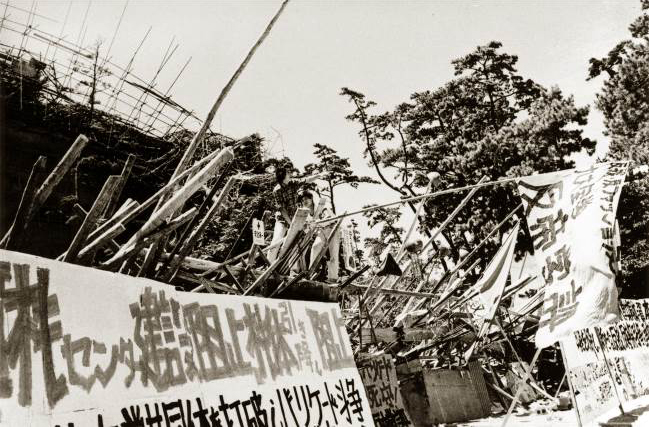
Barricade built in front of the Computer Center
Universities rode the wave of high economic growth and continued to expand. On the other hand, they also ran into the problem of the so-called "Mass-production education". The Haneda Incident, which occurred in 1967, was the trigger for the vitalization of student movements nationwide. At Kyushu University, the so-called “Sanpazengakuren” which had been protesting the USS Enterprise, a nuclear-powered aircraft carrier, entering port Sasebo, occupied a building of the College of General Education in January 1968. Thus, Kyushu University began to be embroiled in the university dispute.
In addition, on June 2 a Phantom II based in Itazuke Air Base crashed and burned on the under-construction computer center building. This incident shocked people both inside and outside the university. Teaching staff and students conducted protest actions together, for example, they held a demonstration in Fukuoka city lead by the president in which they called for the removal of the Itazuke Air Base. However, a part of the students opposed the removal of the airframe, which intensified the antagonism between the students and the university authorities. In the end, the airframe was removed in January of the following year. However, as new legislative measures were taken to deal with the growing dispute with the university, these measures intensified the conflict. Main campus buildings such as a building for administration office were blockaded by students. Many faculties went on indefinite strike from May onwards, and as a result, the university fell into disorder. In the end, the university authorities used the riot police to lift the blockade on October 14. It still took some time for things to completely return to normal, as, for instance, students from the faculty of medicine would still strike for a long time.
Establishment of Kyushu Institute of Design
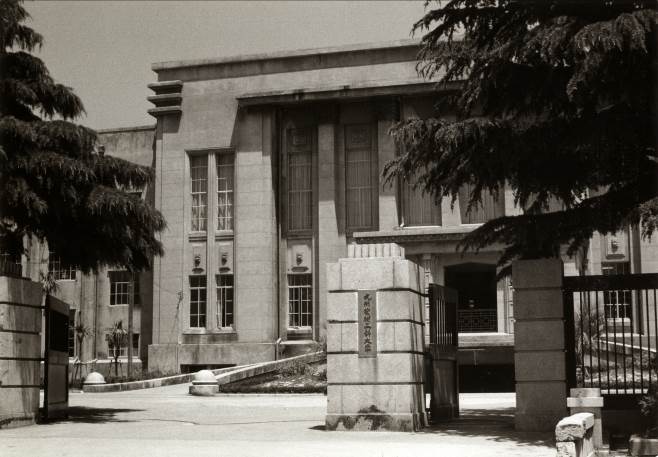
Kyushu Institute of Design - Main Gate (Around 1968)
In April 1968, the Kyushu Institute of Design, which would later merge with the University of Kyushu, was established in Shiobaru, Fukuoka city, during the period in which the University was embroiled in strife. It started with the decision to move the buildings of the Fukuoka Gakugei University’s Fukuoka Campus (today’s Fukuoka University of Education). In 1962 the Cultural Promotion Council of Kyushu held a vote to request that the remaining site was to be used for the establishment of a National University of the Arts. In the following year, the Association for Promoting the Establishment of Kyushu’s National University of the Arts was launched, and in 1964, the government started the survey for the establishment at their request. In this process, they advocated for the foundational principles of the university to be a place that conducts research that aims to combine arts and science and tries to train designers who have both scientific knowledge and artistic sensitivity. This philosophy was called "Geijutsu Kogaku (Design)" (or “Fine Arts Engineering”) and was a new idea in Japanese universities. The Institute of Design of Kyushu was established as a university with a totally new discipline which never existed in Japan before. Its first president was Shinji Koike.
When it was founded, four departments were installed: The Departments of Environmental Design, Industrial Design, Visual Communication Design, and Acoustic Design. The Department of Art and Information Design was later added in 1997. In 1977 master's courses, and in 1993 doctoral course were added. Though the university used old school buildings of the former Fukuoka Gakugei University at first, the construction of a more suitable campus for the concept of "Geijutsu kogaku (Design)" was planned since the start. From the fiscal year of 1970 onwards, buildings meant to realize the idea of "Design" were built one after another: A building for workshops, a laboratory for special ecological examination, a building for multi-dimensional design laboratories, and a building for printing examination.
Establishment of the School of Health Sciences and Joint-Use Facilities
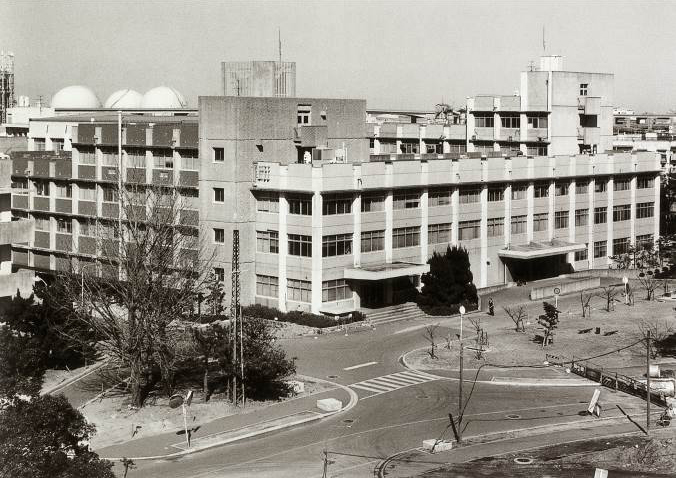
School of Health Sciences – Main Building
(Completed in 1977)
At Kyushu University, various schools which nurtured medical technicians such as nursing schools were established since its early days. In the 1960s, with the improvement of medical technology, it became necessary to improve the capability of medical technicians and to resolve the increasing demand for workers by increasing medical facilities and patients. Under these circumstances, in April 1971, the School of Health Sciences was founded by integrating the Schools of Nursing, Radiological Sciences, and Medical Technology which were attached to the Faculty of Medicine. It consisted of three divisions (which became departments later): Nursing, Radiological Sciences, and Medical Technology. The School of Health Sciences unified the Midwife School and opened an Advanced Course in Midwifery as a postgraduate special course.
Due to an amendment of the Ordinance for Enforcement of National School Establishment Law in April 1966, universities became able to establish joint-use facilities which were independent of departments and were accessible to all departments of the university. At the same time, the Biotron Institute was founded at Kyushu University. Though joint-use facilities would not be built for several years after that, from the 1970s onwards such facilities were founded one after another. These are the present Centers for Leading Scientific Research and Centers for Common Education and Research. There are seventy-seven facilities as of April 2017.
Looking for Reform
Kyushu University started to seek to reform the university after the student movement settled down. In March 1969, the Committee for the University System was founded, and they investigated the reformation of the educational and research system. After the committee decided its dissolution in 1971, it naturally ended. However, a Future Planning Subcommittee, which was set up based on the third report of the Committee for the University System, took over the role to study and to deliberate university's general planning.
In this period, reforming the School of General Education became a matter of importance. Standards for the Establishment of Universities were revised, and a flexible program for general education was to be allowed in and after 1971. Thus, packed schedules for general education programs were to some degree reduced at Kyushu University. In 1974, the School of General Education proposed to reform and establish itself as a new faculty. The Future Planning Subcommittee submitted this plan as the so-called "Sogo Gakubu" (school of integrated arts and science) plan to the University Senate in the following year. However, the plan was judged infeasible and broke down.
In the same period, Kyushu University aimed to establish a graduate school for interdisciplinary research. After the enactment of the Standards for Establishment of Graduate Schools in 1974 and the revision of the School Education Act in 1976, it was accepted to establish independent graduate schools and departments which were not connected with specified undergraduate faculties and departments. Kyushu University began founding independent departments in the Graduate School of Engineering in 1975 and established the Interdisciplinary Graduate School of Engineering Sciences as an independent graduate school for science and engineering in April 1979. The Interdisciplinary Graduate School of Engineering Sciences consisted of the Departments of Materials Science and Technology, Molecular Science and Technology, Energy Conversion Engineering, and Information Systems. It was the first interdisciplinary graduate school of Kyushu University.
Entering the 50s of the Showa period (1975-1984), internationality and informatization were regarded as important at universities. In and after the 1980s, the number of overseas students rapidly increased. In April 1980,
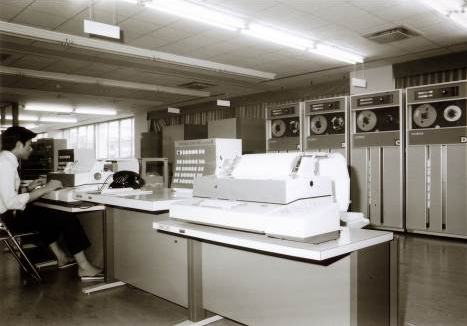
Computer Center(1970)
Kyushu University opened its International Student Center, and, as the first university in Japan to do so, appointed a full-time lecturer in charge of overseas students. In January 1984, Kyushu University constructed its International Student House and provided international students with places to live. In February 1981, the first agreement of exchange was concluded with the First, Second, and Third University of Bordeaux. Since then, Kyushu University concluded agreements with various institutions such as universities all over the world, and the exchange of research and education was stimulated.
Regarding information education, Kyushu University constructed its University Computation Center in May 1962, and its Large-Scale Calculation Center in June 1969 as a national joint-use facility. The university established its Educational Center for Information Processing in April 1977 and started full-scale information education. These three facilities and the KITE Network Operation Center (opened in January 1994) were united into the Computing and Communications Center (reorganized as the Research Institute for Information Technology in April 2007) in April 2000. In March 1994, the university constructed KITE: Kyushu University Integrated Information Transmission Environment, and its performance has been enhanced continuously. Thus, computerization and information education have been improved at Kyushu University.
Construction of Chikushi Campus
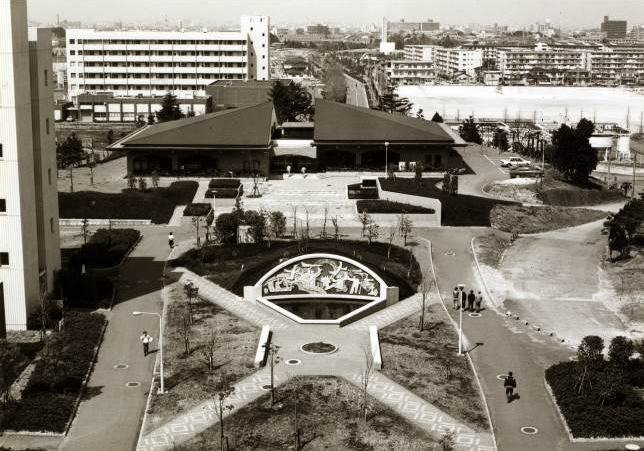
Welfare Facilities of Chikushi Campus (built 1982)
Kyushu University had difficulties to expand its institutions because of its scattered and narrow campuses. The merge and relocation of faculties were the topics discussed at Kyushu University in those days. In 1972, the United States announced that it would return the land of Kasuga’s Military Base to Japan. Kyushu University decided to appeal to relocate the entire campus to the old military base. However, the cities of Onojo and Kasuga hoped to be able to use the land themselves. In addition, both local governments took strong objection to Kyushu University's relocation to Kasuga because of the campus disputes that had occurred previously. As a result, Kyushu University abandoned its plan to relocate the entire university and decided instead to transfer only some research institutes.
Relating to the plan of relocation to Kasugabaru, the Institute of Health Science was established in April 1978. The institute was set up by reshuffling teaching staffs of health and physical education of the University Health Center (established in June 1967) and of the School of General Education. The role of the Institute of Health Science was to conduct research on health science and health and physical education, and to provide healthcare services and physical education. Internally at the university, the Institute of Health Science was regarded as equivalent to institutes attached to the university. After it was resettled in the new campus, branches were set at each campus: Hakozaki, Hospital, and Ropponmatsu.
In the end, Kyushu University gained 190,000 square meters of the land of Kasuga’s US military base and started construction works in 1980. From the following year to 1983, the Research Institute of Science and Industry, the Interdisciplinary Graduate School of Engineering Sciences, the Institute of Health Sciences, and the Research Institute of Applied Mechanics relocated to the new campus named “Chikushi-chiku” in that order.
Expansion of the Library and Reorganization of Affiliated Institutes
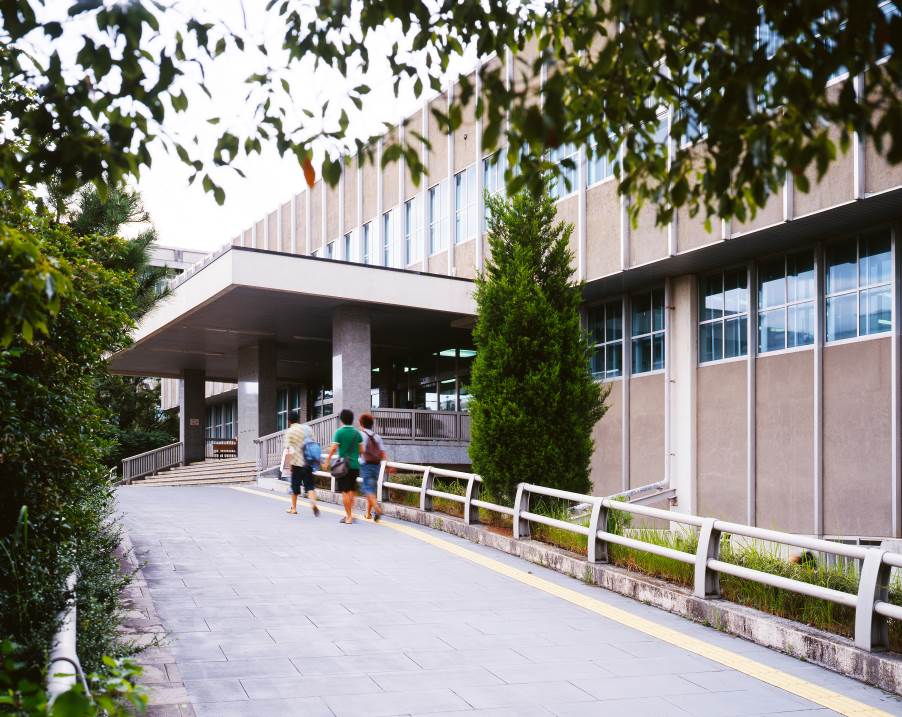
Central library(Completed in 1972)
Although the central library planned to move to the same campus with humanities faculties, the relocation site was changed to an adjacent site to the Faculty of Agriculture because of the sudden increase of stored books. A new central library with a storage capacity of 500,000 books capacity was completed in November 1972 and commenced operations in March of the following year. In 1980 and 1982, the new building of a branch library of the School of General Education and a new building of a branch library of the Faculty of Medicine were opened in the respective years.
In the 40s of the Showa period (1965-1974), the Ministry of Education entirely reviewed institutes attached to universities and requested universities to abolish or reform institutes which were deemed to have finished their role in history. At Kyushu University, the Research Institute of Industry and Labor was closed in March 1979. In April 1982, the Research Institute of Balneotherapeutics and the Institute of Cancer Research were consolidated and reorganized into the Medical Institute of Bioregulation which conducts research on intractable diseases such as immunologic disease and cancer.
Student Life after the Campus Disputes
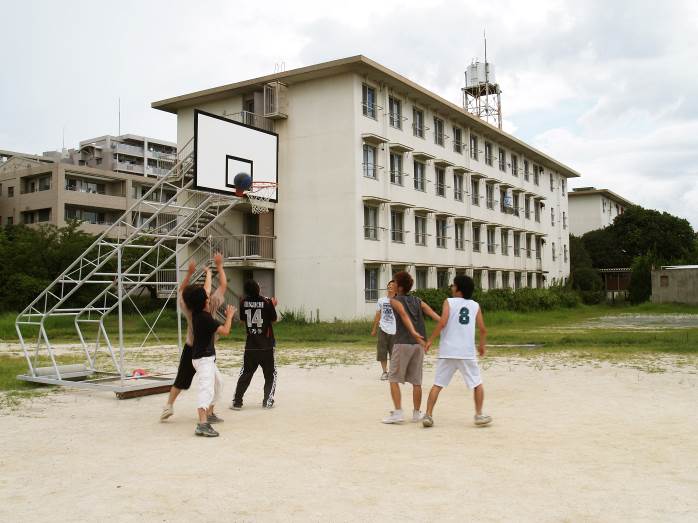
Tashima Dormitory(2007)
In 1968, which was the midst of the campus disputes, Japan ranked second in GNP among all capitalist countries and established itself as one of the largest economic powers. Japanese standards of living improved, and the days of hardships and poverty were already a thing of the past for most Japanese. In this changing social situation, student movements after the campus disputes had declined rapidly.
With the change of the social situation, student life also changed rapidly. As a remarkable change the mandatory school uniform referred to as Tsumeeri (school uniform for boys, jacket with a standing collar) disappeared with the university dispute as a turning point. The residential style of students also changed. The number of boarding students decreased and the number of students who lived alone in apartments increased instead. The so-called “Tajima-ryo”, a residence hall of Kyushu University, which was a relocated and reconstructed dormitory of the former Fukuoka Higher School called “Gakuji-ryo”, saw many students disliking having to share a room and as a result, the number of occupants decreased rapidly. In 1977, Tajima-ryo was rebuilt as a new residence hall with private rooms. It was the first dormitory of the national universities in Japan to build private rooms.
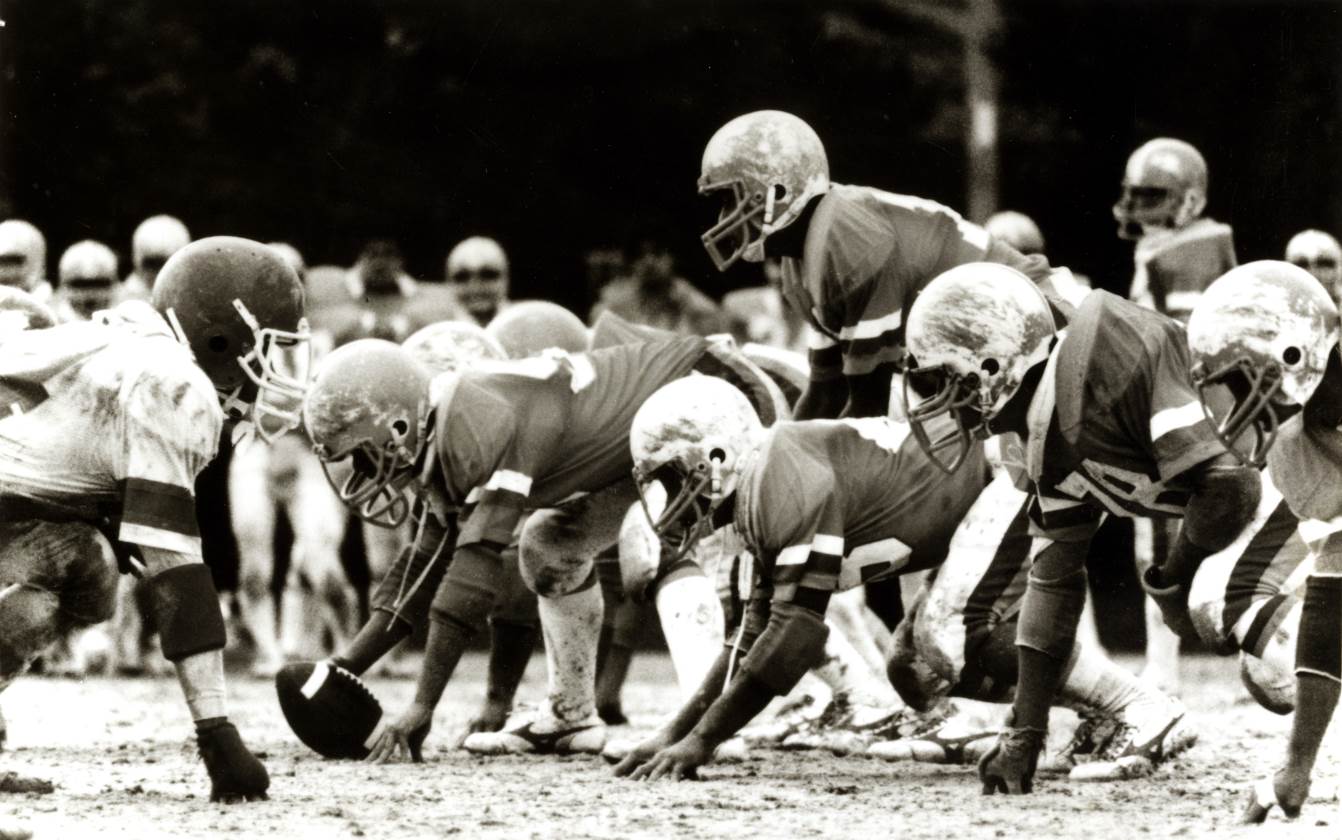
American Football club
In this period, club activity diversified, and both cultural and sports clubs were established one after another. Gymnasiums and shared facilities for extra-curricular activities were built at each campus and made accessible for club activities. University students had more options for entertainment and other activities such as club activities, and as a result, the ways that students could spend their energy, which they had previously used in the student movements, diversified too.
6Reorganization of Kyushu University
Abolishment of the School of General Education and Prioritization of Graduate Schools
To reform the School of General Education was a long-pending question for Kyushu University. Reforms were carried out even after the failure of the “Sogo Gakubu” (総合学部) plan, such as the establishment of the Institute of Language and Cultures which consisted of language teachers who were transferred from the School of General Education in April 1988.
A tendency of emphasizing special education accelerated after the University Establishment Standards were outlined of 1991. As a result, the Schools of General Education were reformed or abolished at all universities. At Kyushu University, it was closed in March 1994, and general education shifted to general education offered for all faculties.
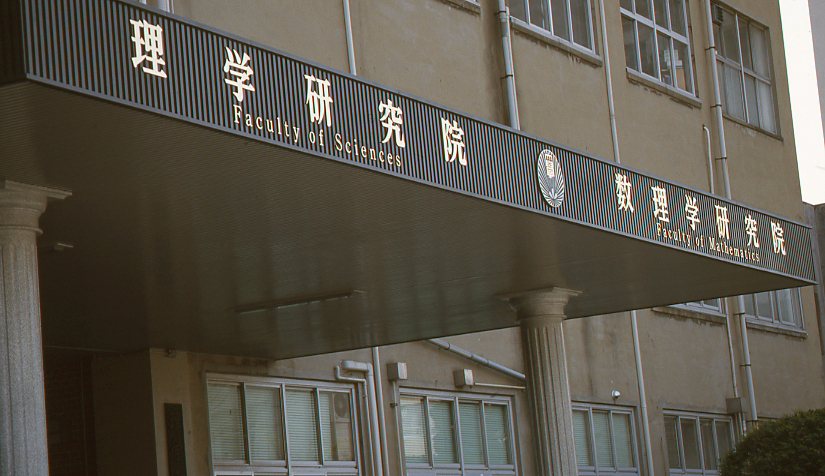
Faculty of Science・Faculty of Mathematics(2000)
New graduate schools were established in succession after the School of General Education was closed. On the abolishment of the School of General Education, the Graduate School of Social and Cultural Studies, which mainly consisted of teaching staff that belonged to the former School of General Education, was opened in April 1994. At the same time, the Graduate School of Mathematics was established, and the members of the teaching staff were mathematics teachers who belonged to the Department of Mathematics of the Faculty of Sciences, the Division of Mathematics of the Faculty of Engineering, and the former School of General Education.
In April 1996, the Graduate School of Information Science and Electrical Engineering was established with the aim of cooperation and development of the fields of information science and electrical engineering. In April 1998, the Graduate School of Human-Environment Studies was founded to establish a new discipline which was integrated and developed from the fields of psychology, sociology, anthropology, pedagogy, health science, and architecture. On the other hand, in the existing faculties and departments, the prioritization of graduate schools started with the Graduate School of Medical Sciences and the Graduate School of Engineering in 1997.
In those days, Kyushu University began earnestly promoting cooperation with society such as by cooperating with industry. Faculties had already conducted cooperative research with enterprises before that. The university set up joint-use facilities for cooperative research and aimed at becoming a more open university to society.
The Graduate School/Faculty System and the Launching of the National University Corporation Kyushu University
In April 2000, Kyushu University launched the Graduate School/Faculty System as distinctive systems of education and research respectively. It completed the prioritization of the graduate schools and ensured that organizations were able to flexibly cooperate by categorizing "Graduate Schools" as educational organizations and "Faculties" as research organizations. Faculty members basically belonged to any of the research organizations and became able to participate in a diverse range of education beyond the frame of the former faculties.
In July 1999, the year that preceded the establishment of this system, the “Act on General Rules for Incorporated Administrative Agency” was revised, and it was decided to transform government organizations into an independent administrative corporation. National universities including Kyushu University took strong objection to this transformation. The incorporation of national universities was once suspended but became unavoidable at last. In June 2001, the Ministry of Education, Culture, Sports, Science and Technology declared that national universities were to be regarded as corporate bodies. The National University Corporation Law was enacted in July 2003, and eighty-nine national university corporations were established in April 2004.
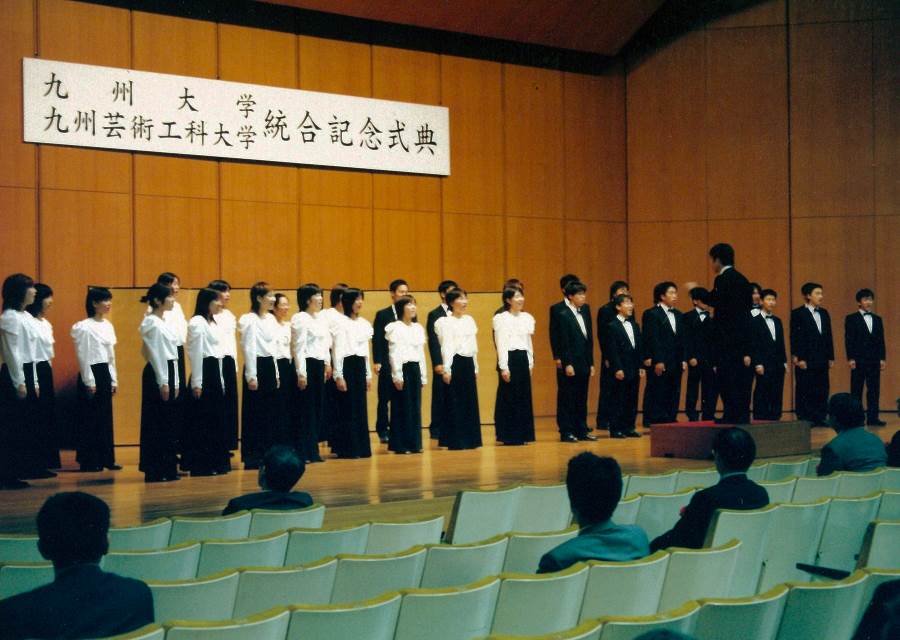
Kyushu University and Kyushu Institute of Design
Integration Signing Ceremony(2001)
In line with the incorporation of national universities, each university was required to respond in any way. The integration of Kyushu University and the Kyushu Institute of Design was one of the measures taken to deal with this situation. The Kyushu Institute of Design was integrated into Kyushu University in October 2003 and became the Faculty of Design at Kyushu University.
The "National University Corporation Kyushu University" was launched on April 1, 2004. The president’s responsibility regarding the university’s management and administration was strongly demanded. Outside experts began to participate in the president selection committee and the management council of the university. Planning unique strategies for Kyushu University became possible, and the university engaged in various initiatives aiming to become one of the world’s top-level universities both in research and education.
In the same period of the incorporation of universities, the establishment of new graduate schools and the reformation of research institutes were carried out. The Graduate School of Systems Life Sciences which unified life science, informatics, and engineering was established in April 2003. In April 2009, the Graduate School of Integrated Frontier Sciences was established aiming to solve problems in the new field through the integration of segmented knowledge. Professional Graduate Schools were also opened such as the Educational Institute for Law which was founded in April 2004. The Institute of Advanced Material Study, which was reorganized from the Research Institute for Production Science in May 1987, and the Institute for Fundamental Research of Organic Chemistry were integrated and established the Institute for Materials Chemistry and Engineering in April 2003. The International Institute for Carbon-Neutral Energy Research (I2CNER) was selected as the top-level Institute of WPI: World Premier International Research Center Initiative by MEXT and was established in December 2010. The 21st Century Program was launched in April 2001 as an interdisciplinary education program which aims to develop "highly specialized generalists". The Faculty of Arts and Science was set up in 2011 and reformed the general education program provided for all faculties and started to provide an education program to nurture "active learners" in 2014.
Integration and Relocation to Ito Campus and Redevelopment of Hospital Campus
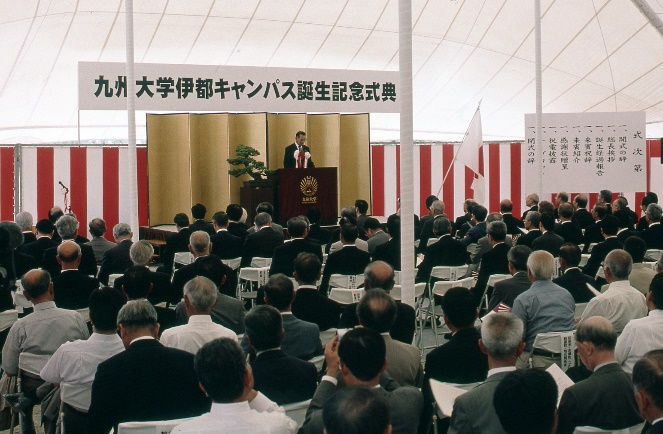
Ito Campus Establishment Opening Ceremony(2005)
For Kyushu University, the relocation of the Hakozaki Campus due to issues with noise disturbance and the growing lack of space without room for expansion was a long pending question. In October 1991, Kyushu University decided to construct a new campus in the west of Fukuoka city, and relocate and integrate Hakozaki, Ropponmatsu, and Haru-machi campuses, therefore, solving the question and create a central hub for the university.
As the construction site, an area including water source area and many historic ruins was chosen. Kyushu University started preparing the area in June 2000 and proceeded construction considering its environment meaning the preservation of historic sites, conservation of groundwater, preserving and restoring trees, and so on. The new campus was
named "Ito campus". Engineering-related faculties moved to the new campus in October 2005, faculties in the former Ropponmatsu campus moved in April 2009, and science-related faculties did in October 2015. The university planned to complete campus relocation in the fiscal year 2018. Once it was completed, it would become Kyushu University’s largest campus with the extensive ground covering 275ha, facilities with a total floor area of roughly 500,000 square meters, and a population of about 16,000 who learn, educate, and conduct research. With Ito Campus at its core, the concept of the “Kyushu University Academic City” steadily advanced as the University proceeded to cooperate with local governments to aim to create “knowledge clusters” and “knowledge cores”.
On the other hand, entering the 1990s, the problem of hospital facilities that, after 30 to 40 years of use, had become degraded and cramped became apparent and solving these problems became an issue. Since at the same
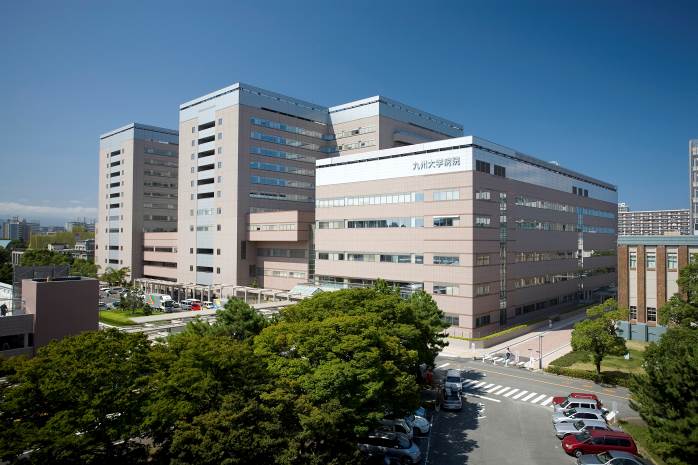
Kyushu University Hospital(2009)
time the relocation and integration of campuses had been decided upon, it was considered to also move the hospital to Ito. However, considering issues such as the convenience for patients it was decided upon to instead find a new location.
The construction of a new hospital began in 1997 and was completed in 2009. The new hospital started operations in the same year. During this period, three hospitals affiliated with the Faculty of Medical Sciences, the Faculty of Dental Science, and the Medical Institute of Bioregulation merged to form the Kyushu University Hospital. The new hospital engages in the promotion of highly advanced medical treatment, strengthening cooperation with community medicine, and so on as a core hospital of Western Japan.
Development of International Exchange
International exchange at Kyushu University became active in and after the 1980s, and it has gained momentum more and more after entering the 21st century. Agreements both at the university level and at faculty level have increased suddenly. The number of international students whom Kyushu University accepted also increased rapidly and exceeded 1,000 in 2007 and 2,000 in 2015.
Kyushu University had accepted many international students from Asian countries since before the Second World War and had also actively conducted research in Asia. The international strategy of Kyushu University is Asia-orientated due to its historical background and geographical setting. The Conference of Asian University Presidents (CAPs) has been held on the initiative of Kyushu University since 2000. Kyushu University established many institutes of education and research relating to Asia. "Degree Programs in English" was launched in 2010 and has offered degree-granting programs with English as the language of instruction. International exchange at Kyushu University is progressing more and more centering on the relationship with other Asian countries.
Student Life in the Heisei Period
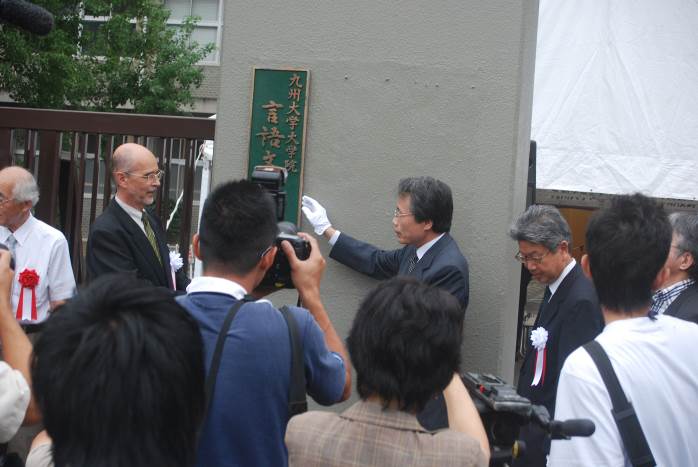
Pesident Arikawa and Dr. Wolfgang Michel remove the
nameplate of the Research Institute for Languages and
Cultures(2009)
The closing ceremony of Ropponmatsu Campus was held in September 2009 and ended more than 80 years of history. For many of the former students of Fukuoka Higher School and Kyushu University, Ropponmatsu Campus was a memorable place which they spent their late teens and enjoyed their youth.
In the final year, commemorative events were held, and people of Fukuoka and people with ties to the university were saddened by its closing.
Most of the last students of Ropponmatsu Campus were born in 1989 and 1990 around the start of the Heisei period. The beginning of the Heisei period was marked with the peak of Japan’s economic bubble. In the early Heisei period, university students tended to enjoy their student life as a reaction of the fierce "examination war”, and universities were therefore ridiculed as "leisure lands". As the job market for students was a "seller's market", most of the students did not need to worry about getting a job after their graduation.
After the collapse of the bubble economy, however, Japan’s economic condition worsened, and the employment situation of students fell into a state referred to as an “ice age”. Although the condition temporarily recovered, students' job-seeking season had been starting earlier and getting longer due to the influence of, among other things, the abolition of the recruitment agreement. It also had a bad influence on the students' studies. The number of students who were forced to leave school or to take a leave of absence increased. In response to this situation, Kyushu University launched support programs for students to support job hunting activities such as the university’s Job Fair and began to support studying at the university by means of providing an original independent scholarship program, et cetera.
“Opening the Door to a New Century of Knowledge”
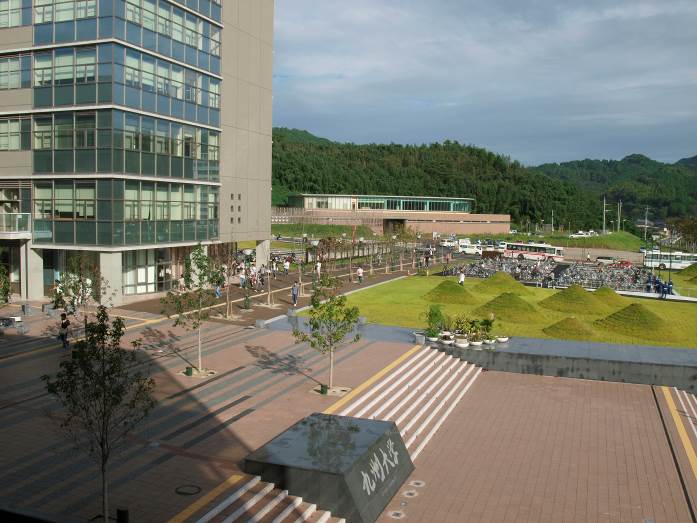
Ito Campus Central Square
The year 2011 marked the 100th anniversary of the foundation of Kyushu University. The Imperial University of Kyushu started with two colleges 100 years ago and has developed into its current form as the University of Kyushu which consists of eleven Under Graduate Schools, eighteen Graduate Schools, sixteen Faculties, four research institutes, the Faculty of Arts and Science and many other research and education facilities. In 2018, Kyushu University plans to open the School of Interdisciplinary Science and Innovation based on the concept of "Innovating Together". It means developing conceptual visions and creating new objects and ideas together by blending differing perspectives and academic knowledge by working together between diverse individuals in a global society. Kyushu University continues to make new and various efforts to aim to "Open the Door to a New Century of Knowledge" as a globally leading center of academic productivity and excellence.
Kyushu University was selected for inclusion in the Top Global University Project in 2014. It was designated as a Type A (superior) grantee, the category for universities conducting world-class education and research that has the potential to be counted among the World University Rankings first 100 institutions. Kyushu University's basic philosophy is to "continue autonomous reforms as well as to ensure an international quality of education, and to become a center of research and education of the highest standards, full of vitality, and constantly addressing future challenges". Kyushu University continues to work forward to establish a world top-level education and research hub.








